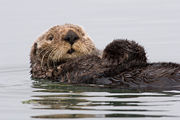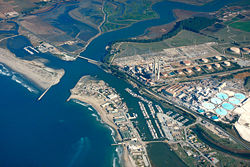
Elkhorn Slough
Encyclopedia


River delta
A delta is a landform that is formed at the mouth of a river where that river flows into an ocean, sea, estuary, lake, reservoir, flat arid area, or another river. Deltas are formed from the deposition of the sediment carried by the river as the flow leaves the mouth of the river...
and estuary
Estuary
An estuary is a partly enclosed coastal body of water with one or more rivers or streams flowing into it, and with a free connection to the open sea....
on Monterey Bay
Monterey Bay
Monterey Bay is a bay of the Pacific Ocean, along the central coast of California. The bay is south of San Francisco and San Jose, between the cities of Santa Cruz and Monterey....
in Monterey County, California
Monterey County, California
Monterey County is a county located on the Pacific coast of the U.S. state of California, its northwestern section forming the southern half of Monterey Bay. The northern half of the bay is in Santa Cruz County. As of 2010, the population was 415,057. The county seat and largest city is Salinas...
. The community of Moss Landing
Moss Landing, California
Moss Landing is a census-designated place in Monterey County, California, United States. Moss Landing is located on the Pajaro Valley Consolidated Railroad north-northeast of Monterey, at an elevation of 10 feet . As of the 2010 census, the CDP population was 204, down from 300 at the 2000...
and the huge Moss Landing Power Plant
Moss Landing Power Plant
The Moss Landing Power Plant is a natural gas powered electricity generation plant located in Moss Landing, California, at the midpoint of Monterey Bay. The plant's large stacks are landmarks, visible throughout the Monterey Bay Area.-History:...
are located at the mouth of the slough on the bay.
Elkhorn Slough harbors the largest tract of tidal salt marsh
Salt marsh
A salt marsh is an environment in the upper coastal intertidal zone between land and salt water or brackish water, it is dominated by dense stands of halophytic plants such as herbs, grasses, or low shrubs. These plants are terrestrial in origin and are essential to the stability of the salt marsh...
in California outside of San Francisco Bay
San Francisco Bay
San Francisco Bay is a shallow, productive estuary through which water draining from approximately forty percent of California, flowing in the Sacramento and San Joaquin rivers from the Sierra Nevada mountains, enters the Pacific Ocean...
and provides much-needed habitat for hundreds of species of plants and animals, including more than 340 species of birds. More than 5,000 acres of the Elkhorn Slough area are preserved. The slough's wildlife and habitats are protected primarily by two marine protected area
Marine Protected Area
Marine Protected Areas, like any protected area, are regions in which human activity has been placed under some restrictions in the interest of conserving the natural environment, it's surrounding waters and the occupant ecosystems, and any cultural or historical resources that may require...
s, the Elkhorn Slough State Marine Reserve (SMR) and Elkhorn Slough State Marine Conservation Area (SMCA). The combined areas cover 1.57 square miles (4.1 km²). All marine life is protected within the reserve, while in the SMCA limited fishing and clam taking is permitted.
Preservation
The Elkhorn Slough National Estuarine Research ReserveElkhorn Slough National Estuarine Research Reserve
The Elkhorn Slough National Estuarine Research Reserve is one of 28 National Estuarine Research Reserves established nationwide as field laboratories for scientific research and estuarine education. The Slough is located approximately south of San Francisco, California on the central shore of...
is one of 27 National Estuarine Research Reserves established nationwide as field laboratories for scientific research and estuarine education.
The nonprofit Nature Conservancy was the first to buy Elkhorn Slough property with to protect the area's habitat and wildlife. The Nature Conservancy started with only 60 acres in 1971 and now owns over 800 acres. The nonprofit Elkhorn Slough Foundation also owns and protects over 1,700 acres of Elkhorn Slough.
Marine Protected Areas
The Elkhorn Slough State Marine Reserve (SMR) and the Elkhorn Slough State Marine Conservation Area (SMCA) were established in September 2007 by the California Department of Fish & Game. It was one of 29 marine protected areas adopted during the first phase of the Marine Life Protection Act Initiative. The Marine Life Protection Act Initiative (or MLPAI) is a collaborative public process to create a statewide network of marine protected areas along the California coastline.Elkhorn Slough SMR and SMCA are adjacent to the Moss Landing Wildlife Area and are near the Moro Cojo Estuary State Marine Reserve.
Elkhorn Slough State Marine Reserve
The Elkhorn Slough SMR covers 1.48 square miles (3.8 km²). The SMR protects all marine life within its boundaries. Fishing and take of all living marine resources is prohibited. It includes the waters below mean high tide within Elkhorn Slough lying:- east of longitude 121° 46.40’ W. and
- south of latitude 36° 50.50’ N.
Elkhorn Slough State Marine Conservation Area
The Elkhorn Slough SMCA covers 0.09 square mile (0.2330989299 km²). It includes the waters below mean high tide within Elkhorn Slough:- east of the Highway 1 Bridge and
- west of longitude 121° 46.40’ W.
Harvest of finfish (by hook-and-line only) and clams are allowed within the conservation area only. Clams may only be taken on the north shore of the slough
Slough
Slough is a borough and unitary authority within the ceremonial county of Royal Berkshire, England. The town straddles the A4 Bath Road and the Great Western Main Line, west of central London...
in the area adjacent to the Moss Landing State Wildlife Area.
Habitat and wildlife
Elkhorn Slough, one of the largest estuariesEstuary
An estuary is a partly enclosed coastal body of water with one or more rivers or streams flowing into it, and with a free connection to the open sea....
in California, provides essential habitat for over 700 species, including aquatic mammal
Mammal
Mammals are members of a class of air-breathing vertebrate animals characterised by the possession of endothermy, hair, three middle ear bones, and mammary glands functional in mothers with young...
s, birds, fish, invertebrate
Invertebrate
An invertebrate is an animal without a backbone. The group includes 97% of all animal species – all animals except those in the chordate subphylum Vertebrata .Invertebrates form a paraphyletic group...
s, algae and plants. The numerous vegetative species include such wildflowers as Yellow Mariposa Lily, Calochortus luteus
Calochortus luteus
Calochortus luteus, or Yellow mariposa lily, is a mariposa lily endemic to California.-Description:The primarily a bright deep yellow flower is 3-5cm across and perianth Bulb-shaped, lined red-brown inside, often also with central red-brown blotch and sparse hair inside.-Distribution:This species...
.
Elkhorn Slough hosts year-round residents tightly associated with estuaries, such as pickleweed
Pickleweed
Pickleweed is a common name used for two unrelated genera of flowering plants:*Batis, family Bataceae*Salicornia, family Amaranthaceae...
, eelgrass
Vallisneria
Vallisneria is a genus of freshwater aquatic plant, commonly called eelgrass, tape grass or vallis. The genus has 6-10 species that are widely distributed, but do not grow in colder regions....
, oyster
Oyster
The word oyster is used as a common name for a number of distinct groups of bivalve molluscs which live in marine or brackish habitats. The valves are highly calcified....
s, gaper clams, and longjaw mudsucker
Longjaw mudsucker
The longjaw mudsucker Gillichthys mirabilis is a goby of the Pacific Ocean coast of California and Baja California, noted for its extremely large mouth and ability to survive out of water for short periods....
s, as well as important seasonal visitors such as migratory shorebirds, sea otters, and sharks and rays. Habitat types include mudflats, tidal creeks and channels.
Recreation
Along with hiking and bird watching, kayaking is a popular activity on the slough. Watching sea otterSea Otter
The sea otter is a marine mammal native to the coasts of the northern and eastern North Pacific Ocean. Adult sea otters typically weigh between 14 and 45 kg , making them the heaviest members of the weasel family, but among the smallest marine mammals...
s, sea lions, seals, brown pelican
Brown Pelican
The Brown Pelican is the smallest of the eight species of pelican, although it is a large bird in nearly every other regard. It is in length, weighs from and has a wingspan from .-Range and habits:...
s, American avocet
American Avocet
The American Avocet is a large wader in the avocet and stilt family, Recurvirostridae.This avocet has long, thin, gray legs, giving it its colloquial name, "blue shanks". The plumage is black and white on the back with white on the underbelly. The neck and head are cinnamon colored in the summer...
s, cormorant
Cormorant
The bird family Phalacrocoracidae is represented by some 40 species of cormorants and shags. Several different classifications of the family have been proposed recently, and the number of genera is disputed.- Names :...
s, egrets, tern
Tern
Terns are seabirds in the family Sternidae, previously considered a subfamily of the gull family Laridae . They form a lineage with the gulls and skimmers which in turn is related to skuas and auks...
s and a host of other wildlife from the water is an experience that provides a unique perspective of how the slough is used by the native inhabitants.
The Elkhorn Slough National Estuarine Research Reserve and Elkhorn Slough Foundation provide on-site management, education, and stewardship and offer public access via 5 miles (8 km) of trails, as well as a Visitor Center and volunteer opportunities.
The nearby Moss Landing Wildlife Area protects 728 acres (2.9 km²) of salt ponds and salt marsh. Limited recreation is permitted within the Wildlife Area.
California’s marine protected areas encourage recreational and educational uses of the ocean. Activities such as kayaking, diving, snorkeling, and swimming are allowed unless otherwise restricted.
The Moss Landiing Harbor District has jurisdiction over the navigable waterways of Elkhorn Slough and owns Kirby Park at the upper reaches of Elkhorn Slough. Kirby park has a small boat launch and provides parking for a small trail on Nature Conservancy property at the north side. The trail here is fully handicapp asccessible and allows a walk and a wheelchair near the waters edge.

